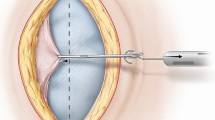Abstract
Background
To provide adequate workspace between the viscera and abdominal wall, insufflation with carbon dioxide is a common practice in laparoscopic surgeries. An insufflation pressure of 15 mmHg is considered to be safe in patients, but all insufflation pressures create perioperative and postoperative physiologic effects. As a composition of viscoelastic materials, the abdominal wall should distend in a predictable manner given the pressure of the pneumoperitoneum. The purpose of this study was to elucidate the relationship between degree of abdominal distention and the insufflation pressure, with the goal of determining factors which impact the compliance of the abdominal wall.
Methods
A prospective, IRB-approved study was conducted to video record the abdomens of patients undergoing insufflation prior to a laparoscopic surgery. Photo samples were taken every 5 s, and the strain of the patient’s abdomen in the sagittal plane was determined, as well as the insufflator pressure (stress) at bedside. Patients were insufflated to 15 mmHg. The relationship between the stress and strain was determined in each sample, and compliance of the patient’s abdominal wall was calculated. Subcutaneous fat thickness and rectus abdominus muscle thickness were obtained from computed tomography scans. Correlations between abdominal wall compliances and subcutaneous fat and muscle content were determined.
Results
Twenty-five patients were evaluated. An increased fat thickness in the abdominal wall had a direct exponential relationship with abdominal wall compliance (R 2 = 0.59, p < 0.05). There was no correlation between muscle and fat thickness.
Conclusion
All insufflation pressures create perioperative and postoperative complications. The compliance of patients’ abdominal body walls differs, and subcutaneous fat thickness has a direct exponential relationship with abdominal wall compliance. Thus, insufflation pressures can be better tailored per the patient. Future studies are needed to demonstrate the clinical impact of varying insufflation pressures.







Similar content being viewed by others
References
Casati A, Valentini G, Ferrari S, Senatore R, Zangrillo A, Torri G (1997) Cardiorespiratory changes during gynaecological laparoscopy by abdominal wall elevation: comparison with carbon dioxide pneumoperitoneum. Br J Anaesth 78:51–54
Bardoczky GI, Engelman E, Levarlet M, Simon P (1993) Ventilatory effects of pneumoperitoneum monitored with continuous spirometry. Anaesthesia 48:309–311
Kamine TH, Papavassiliou E, Schneider BE (2014) Effect of abdominal insufflation for laparoscopy on intracranial pressure. JAMA Surg 149:380–382
Ben-Haim M, Rosenthal RJ (1999) Causes of arterial hypertension and splachnic ischemia during acute elevations in intra-abdominal pressure with CO2 pneumoperitoneum: a complex central nervous system mediated response. Int J Colorectal Dis 14:227–236
Lindgren L, Koivusalo AM, Kellokumpu I (1995) Conventional pneumoperitoneum compared with abdominal wall lift for laparoscopic cholecystectomy. Br J Anaesth 75:567–572
Vlot J, Staals LM, Winjej RM, Stolker RJ, Bax KN (2015) Optimizing working space in laparoscopy: CT measurement of the influence of small body size in a porcine model. J Pediatr Surg 50:465–471
Carew EO, Cooke FW, Lemons JE, Ratner BD, Vesely I, Vogler E (2004) Properties of materials. In: Ratner BD, Hoffman AS, Schoen FJ, Lemons JE (eds) Biomaterials science: an introduction to materials in medicine, 2nd edn. Academic Press, London, pp 23–65
Zorn A (2007) Physical thoughts about structure: the elasticity of fascia. Struct Integr 15–17
Song C, Alijani A, Frank T, Hanna G, Cuschieri A (2006) Elasticity of the living abdominal wall in laparoscopic surgery. J Biomech 39:587–591
Author information
Authors and Affiliations
Corresponding author
Ethics declarations
Disclosures
Dr. Roth is a speaker for CR Bard, MTF, and Life Cell; he receives grant support from Bard, Life Cell, MTF, and Gore; and he is a shareholder in Miromatrix. Chuck Becker, Margaret Plymale, John Wennergren, Crystal Totten, and Kyle Stigall have no conflicts of interest or financial ties to disclose.
Rights and permissions
About this article
Cite this article
Becker, C., Plymale, M.A., Wennergren, J. et al. Compliance of the abdominal wall during laparoscopic insufflation. Surg Endosc 31, 1947–1951 (2017). https://doi.org/10.1007/s00464-016-5201-6
Received:
Accepted:
Published:
Issue Date:
DOI: https://doi.org/10.1007/s00464-016-5201-6




